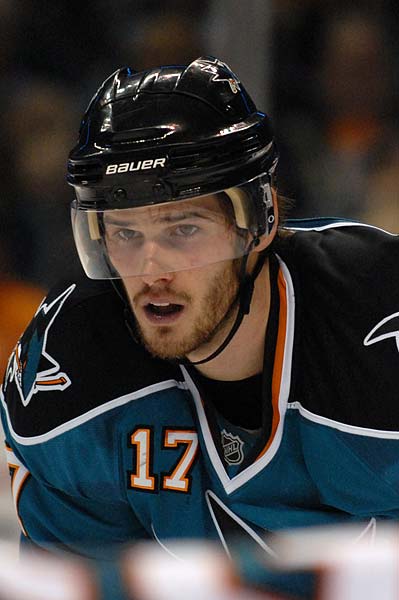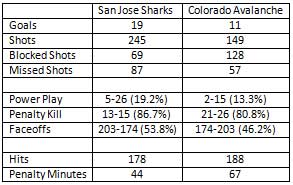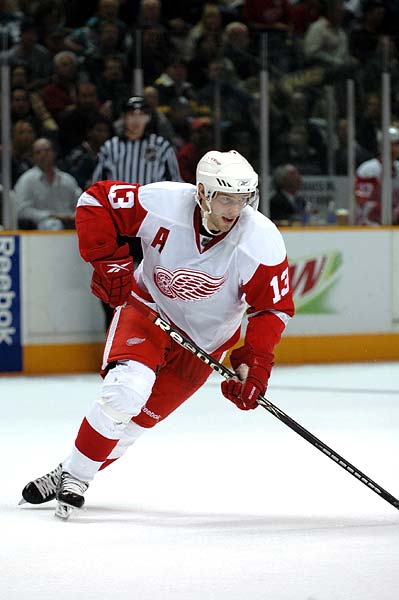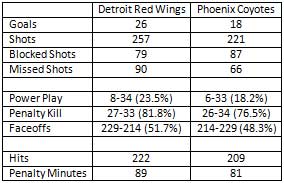WCSF Game 1 preview: A look back at Colorado, a look ahead to Detroit

#17 TORREY MITCHELL JOINED THORNTON AND MARLEAU ON TOP LINE

SAN JOSE DEFEATED COLORADO IN THE WCQF 4-2
San Jose Sharks preview:
The Sharks stressed a theme of overcoming obstacles prior to the start of the 2010 Stanley Cup Playoffs, and they would return to that theme early and often in the first round against the Colorado Avalanche. Odd bounces off of Rob Blake’s skate, Marc-Edouard Vlasic’s throat, and a Dan Boyle shot that deflected off of Ryan O’Reilly’s stick resulted in three own-goals over the first three games. The Avalanche emerged with a 2-1 series lead, each in one-goal affairs, but the tide would turn.
The Sharks stuck with the Todd McLellan philosophy of playing the body hard, funneling shots on net, and trying to wear down a young and hobbled Avalanche squad on both sides of the ice. Colorado quizzically adopted a counter-punching style, laying back in the neutral zone waiting to capitalize on mistakes. Mistakes that either never came, or were swallowed up by a sharp Evgeni Nabokov. The Avalanche may have been taking a page from the Anaheim Ducks one year earlier. The Ducks lulled the Sharks into complacency early, took the series lead, and then let them beat themselves as they tried a desperation comeback.
What worked for San Jose: The Clowe-Pavelski-Setoguchi line combined for 22 points (9 goals, 13 assists), and 6 points (2 goals, 4 assists) on the power play. Joe Pavelski continued a trend of clutch performances with the game tying goal with 32 seconds left in game 2, the overtime game winning goal in game 4, the game winning goal in game 6 as well as an assist on Dan Boyle’s game tying goal in the third period. The 5-foot-11, 190-pound Pavelski thinks the game well, makes a b-line for the front of the net, and plays 20 pounds above his weight. Ryane Clowe is a player in the power forward mould, one head coach Todd McLellan called the Sharks MVP down the stretch. Clowe excelled at winning puck battles in the corner, and creating scoring chances with puck possession around the wings. Devin Setoguchi had to be settled down by teammates after a penalty in game 1, but a voracious forecheck and at times a head hunting style made him a handful for Colorado. If Setoguchi can mimic the puck possession style of Ryane Clowe, take it to the net instead of making plays high in his zone, his goal and penalties drawn totals will skyrocket.
Evgeni Nabokov and Craig Anderson each had a forgettable game 2, but Nabokov quickly worked himself back into the series. An aggressive style that saw him challenge shooters at the top of the crease remained consistent despite anemic shot totals from Colorado. Nabokov allowed a combined 1 goal against in games 4 and 5, and held the Avalanche to 2 goals or less for all but 1 game in the series. Not shaken by a puck that deflected in off the skate of Rob Blake for a game winner in the opening contest, or a puck that beat him on Dan Boyle’s shot in overtime of game 3, Nabokov kept the team pointed in the right direction for the rest of the series. According to HNIC, a heated offseason meeting between general manager Doug Wilson and Nabokov centered around being a better teammate. Nabokov put that into practice during the regular season, and could be one of the most sought after free agents in the offseason. He needs to direct traffic and at times act as a third defenseman when the d is pressured in his zone.
The overwhelming trend was shots on goal in all situations. The Sharks outshot Colorado 245-149, and the disparity was equal with shots that missed the net 87-57. Getting pucks through traffic was a major factor in the series, as the Avalanche averaged over 20 blocked shots a game (21.3). Also notable was the Sharks play late in game 6 with a one goal lead. From the 12 minute mark to the Sharks second empty net goal at 19:29, San Jose got the puck deep in the Colorado zone 8 times. It forced the Avalanche to skate 200 feet for a comeback. They were only able to set up in the offensive zone 5 times, and the scoring chances lacked the intensity and desperation needed to even the series.
What needs work: The Marleau-Thornton-Heatley line was held to 1 goal in the series. Heatley missed game 3 with an undisclosed lower body injury, looked hobbled in game 4, but started to return to form in the final two games. He directed a shot off the post that nearly ended game 4 in overtime. Marleau registered a goal in the 5-0 blowout in game 5, but needs to have more of an impact on both sides of the ice. Shift-to-shift intensity and compete level have been the criteria this blog used to evaluate Marleau and Thornton the last 3 postseasons. This year both could be better. Thornton had spurts where he bull rushed centers on faceoffs, and where he ran over bodies down low, but it needs to happen every shift. As Owen Nolan proved several years ago during the year of hit posts and crossbars, if you are not a factor on the scoreboard, you need to exact a physical toll on the defense, fluster the goaltender with contact, or draw penalties. Thornton finished the first round 58-45 from the faceoff circle.
The Sharks exhibited a little posteason misdirection regarding the fate of Marleau-Thornton-Heatley for game 1. There have been hints Todd McLellan will leave Torrey Mitchell up on the top line with Patrick Marleau and Joe Thornton. Heatley skated on a line with rookie Logan Couture and center Manny Malhotra. San Jose Mercury News opinion columnist Mark Purdy speculates Patrick Marleau could join a checking line with Manny Malhotra and Torrey Mitchell. Todd McLellan could reunite “the big three” 5-on-5, but they should be reunited regardless on the power play.
The Sharks were disciplined in their own zone, but the pressure will be on the defense with the amount of bodies Detroit likes to plant in front of the crease. Rob Blake, Jason Demers and Kent Huskins will have to maintain that discipline and keep the play at 5-on-5. Huskins and Demers both took large steps forward in the first round, but they will be targeted by the Red Wings in round two. Communicaton between defensive partners, communication with the goaltender, and communication with the forwards will allow them to determine when they have time to play the puck and when they need to make a hard chip off the boards. It needs to happen on every sequence. McLellan’s philosophy of “puck management”, making smart decisions with the puck while moving it out of your zone, will be key against Detroit.
The Sharks first defensive pair of Dan Boyle and Douglas Murray also displayed a few rough edges. This is Murray’s first season on the top d-pair after the departure of Brad Lukowich and Christian Ehrhoff in the offseason. The 6-foot-3, 240-pound Murray blossomed defensively with Ehrhoff by taking straight lines to the puck, and maximizing his size and leverage advantage in front of the net. An intelligent Cornell grad, Murray did not miss a beat playing with Boyle during the first three quarters of 2009-10. Towards the end of the year, coverage mistakes and excess skating started to creep into his game. That was also evident on a few shifts in the first round against Colorado, which Murray admitted to Scott Oake of HNIC during the second intermission of game 6. “We are trying to make too many plays, instead of playing straight lines,” Murray told Oake. If Murray creates a 20-25 foot zone of responsibility around Evgeni Nabokov, and makes strong first pass when he has time, it will bode well for San Jose in the Semifinals.

DETROIT C #13 PAVEL DATSYUK 2 GOALS IN GAME 7 - FILE PHOTO

DETROIT DEFEATED PHOENIX IN THE WCQF 4-3
Detroit Red Wings preview:
The Red Wings also faced a 2-1 deficit in the opening round against Phoenix, but a more informative comparison might be to the regular season finale against the Chicago Blackhawks. With the Sharks finishing their season against Phoenix one night earlier, the Detroit Red Wings dominated the Blackhawks down low en route to a 3-2 overtime win at the United Center. Against a similar speed and puck possession based team, the Red Wings repeatedly pinned the Blackhawks deep and created scoring chances with bodies in front.
A quick look at the Detroit roster shows the usual suspects that will be planted in front of Evgeni Nabokov in round two. Tomas Holmstrom, Todd Bertuzzi, Darren Helm and Dan Cleary will offer a fixture in front on all 4 lines. Gaining body position in front, and taking away the stick will be key factors throughout the series. This doesn’t need to be a “key to the series”, not sure if it even needs to be taught anymore by head coach Mike Babcock, in Detroit it just happens. It is one element of the Detroit style the Sharks utilize often, but have not perfected.
Detroit drew heavily on its veteran leadership in game 7. Pavel Datsyuk and Nicklas Lidstrom each scored a pair of goals, and defenseman Brian Rafalski and Henrik Zetterberg registered 3 assists. The Red Wings picked Phoenix apart, and had them staring at the ice as the final horn rang on their Cinderella postseason. Too often the Sharks have allowed Datsyuk and Zetterberg the space needed to skate and make plays. They need to plant a body on both early and often, then offer an elbow behind the play to make sure they get their point across.
Despite recently turning 40, defenseman Nicklas Lidstrom is still an all-world caliber athlete. He finished third on the team with 49 points (9 goals, 40 assists), but was left out as a finalist in Norris Trophy voting for the first time in recent memory. Lidstrom won the Norris three straight times from 2001-2003, and again from 2006-08. Lidstrom can pick apart a team if given the opportunity. He once fired a 60 foot backhanded saucer pass through the neutral zone at HP Pavilion that lead to a Datsyuk breakaway goal. The Sharks need to burn a few scoring chances a la the Calgary Flames and Edmonton Oilers, dump the puck deep, and hammer Lidstrom and Brian Rafalski as they try to play it. Unless this is a physically grueling series for both, they will beat you.
A scouting report on “rookie” goaltender Jimmy Howard will posted later in the series.
Other series notes: The San Jose Sharks have lost the last four playoff game 1’s, each on home ice. The last time the Sharks were successful to open a series was in 2007. San Jose defeated Nashville 5-4 in double overtime to open the 2007 WCQF, and began the 2007 WCSF series with a 2-0 shutout against Detroit. The Red Wings were 3-0-1 against San Jose in the regular season this year, and hold a 11-6 alltime edge in the playoffs. The Sharks are 25-55-8 alltime against Detroit in the regular season, but have won only 8 of 44 road games at Joe Louis Arena.
Outside of HP Pavilion, the coldest and wettest local weather season in 10 years continues. Heavy rains have helped Califoria emerge from a 3 year drought. San Jose is expecting a winter-like high of 62 (game time should be in the 50’s). More condusive to good ice at HP Pavilion is humidity, and there is a partly cloudy/slight chance of rain on Thursday.
[Update] Red Wings Are Round 2 Opponent – SJsharks.com.
“They are patient and they play well defensively, they wait for you to make mistakes and then they capitalize going the other way,” said Sharks Head Coach Todd McLellan. “We’ve known for a number of years Detroit’s power play can be really successful.”
[Update2] George Malik’s Snap Shots blog at Mlive.com should be considered the Drudge Report of blogs covering this series for San Jose and Michigan fans alike. As the first Californian-born descendant from a long line of Michiganders, let me be the first to say “Lets go Blue”.
[Update3] Sharks – Avs Scoring Chances Totals – Derek Zona for Copper and Blue.







 Editor: Jon Swenson
Editor: Jon Swenson Writer: Max Giese
Writer: Max Giese Writer: Darryl Hunt
Writer: Darryl Hunt